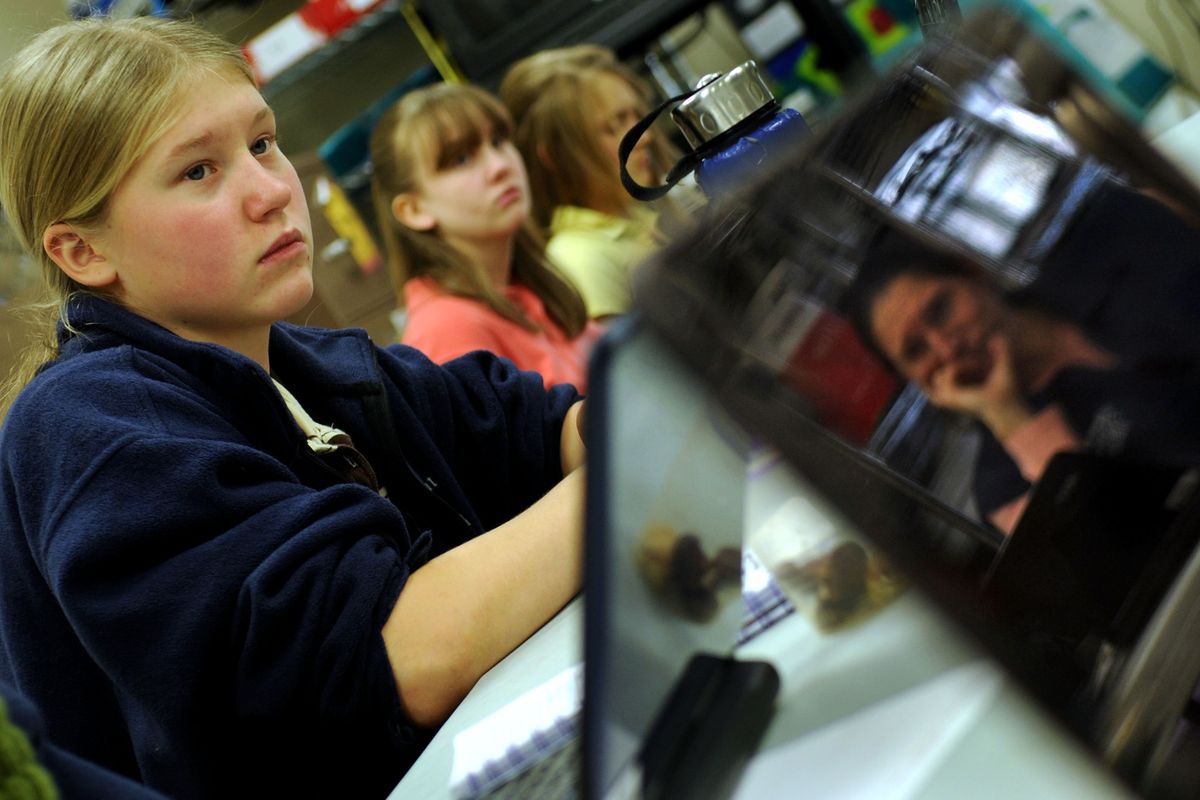More room to learn
Charter school adds grade levels
Sandpoint Charter School ninth-grader Sammy Goding uses a school-issued laptop computer in class on Dec. 2. The school was able to add the ninth and 10th grades this year, and plans to add 11th grade next year.kathypl@spokesman.com (Kathy Plonka)
Walk through the halls of Sandpoint Charter School and you will find most classrooms empty. It’s not because of low enrollment but because the students flock to the computer labs to work on some of the many projects designed to encourage creativity.
While Sandpoint Charter School is a public school, its teaching style differs from a traditional school.
A hands-on, project-based philosophy integrates several of the subjects students study into a project that will help them learn not just one subject but many, at the same time encouraging independent research.
“The role of the teachers is to facilitate the projects,” said Sandpoint Charter School Principal Alan Millar.
Until this year the school only offered grades six through eight.
“We had parents coming in and asking what their options are for high school,” said Millar, who said research shows that once children reach high school years they generally prefer to stay in the setting where they have been.
When it was clear that there was a high demand for the charter school to add higher grades, a group of five teachers and four community members researched options and presented their plan to extend the school to grades nine through 12 to the Lake Pend Oreille School Board.
“The district voted unanimously,” said Millar.
This fall the school opened to 46 students in ninth and 10th grade and will add an 11th grade next year. But it was also important that the older students had their own facility.
Earlier this fall, the district broke ground on a 20,000-square-foot building expected to be completed in March. The building will eventually house up to 200 high school students. It is designed with small classrooms centered around a large common area where up to 75 students will be able to work on their projects on school-provided laptops.
The cost of the building is approximately $1.5 million, 75 percent financed by a loan from USDA Rural Development agency and the other portion financed by a loan from Mountain West Bank.
“The charter schools do not have access to bonds,” Millar said. “Ninety-five percent of our funding is from state money that follows the child.”
Unlike the lower grades in the Sandpoint Charter School, grades nine and 10 have gone paperless. The school provides each student with a mini netbook computer.
“Kids are literally walking down the hall typing,” said Millar, who adds that the education they are providing at the charter school is actually a hybrid of online education with a personal touch.
Freshman Kaitlin Wallace said going to a small high school like the Sandpoint Charter School gives her the advantage of more one-on-one time with her instructors, and she prefers the small-school setting to that of the large traditional public high school.
Teacher Rich Kallage was instrumental in researching the requirements for Sandpoint Charter High School and helped develop graduation requirements.
“It’s an academically challenging environment,” said Kallage, adding that students who attend a charter school develop the ability to take on ambiguous projects and have more initiative when it comes to starting and completing projects – something that will serve them well in postsecondary education.
Millar and Kallage agree that an important aspect of their new high school will be to provide postsecondary guidance, including administering aptitude tests and counseling students about their options after high school.
“Students have a massive amount of information they have to navigate through,” said Millard.
Other philosophies of the Sandpoint Charter School are community involvement and environmental consciousness. While schools nationwide took part in a walk-to-school day in early October, those at Sandpoint Charter School did not stop there. They are taking part in something they call the Greener Mile Project. It is a competition to see which group – teachers and staff versus the classes – can bike or walk to school the most in a given trimester. So far the leading class has biked or walked 244 miles.
All involved with bringing the new high school from vision to reality are enthusiastic about the opportunities it will provide.
“Any change takes a small group of dedicated people,” said Millar.

